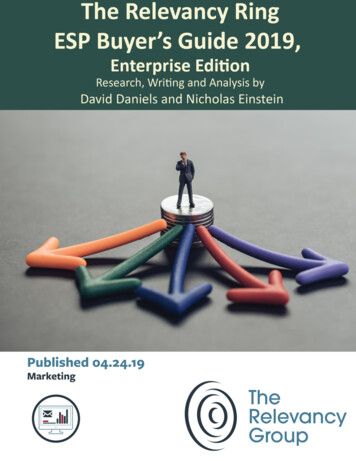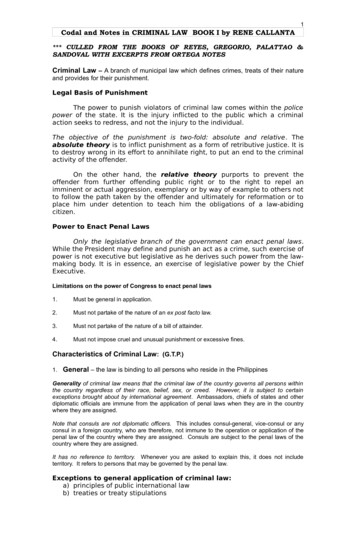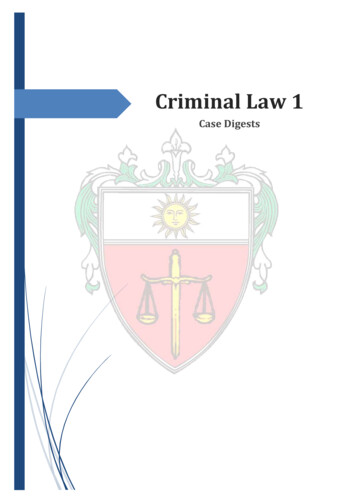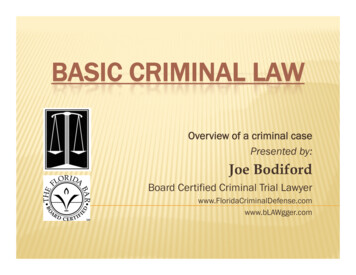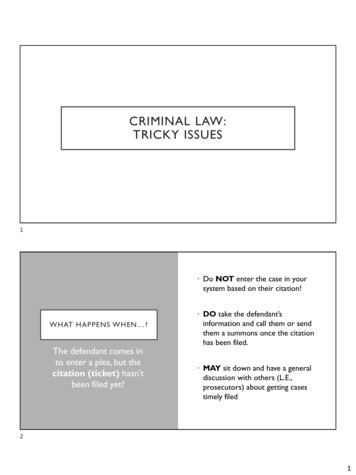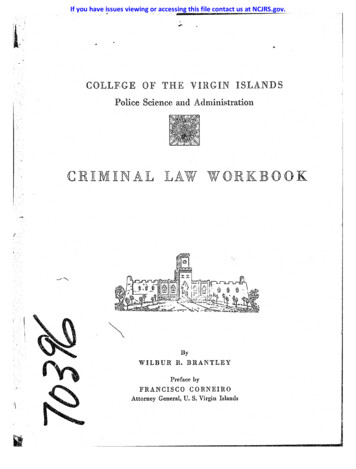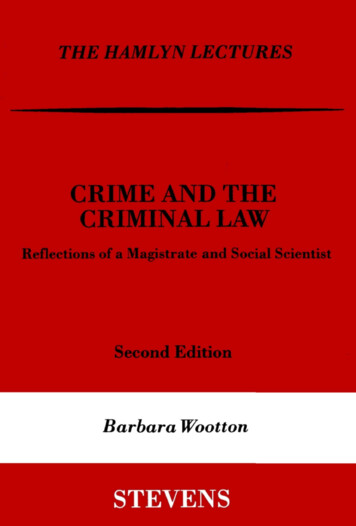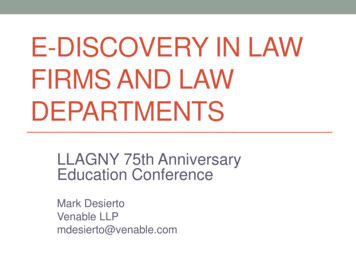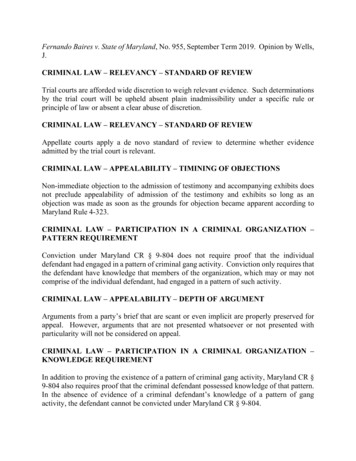
Transcription
Fernando Baires v. State of Maryland, No. 955, September Term 2019. Opinion by Wells,J.CRIMINAL LAW – RELEVANCY – STANDARD OF REVIEWTrial courts are afforded wide discretion to weigh relevant evidence. Such determinationsby the trial court will be upheld absent plain inadmissibility under a specific rule orprinciple of law or absent a clear abuse of discretion.CRIMINAL LAW – RELEVANCY – STANDARD OF REVIEWAppellate courts apply a de novo standard of review to determine whether evidenceadmitted by the trial court is relevant.CRIMINAL LAW – APPEALABILITY – TIMINING OF OBJECTIONSNon-immediate objection to the admission of testimony and accompanying exhibits doesnot preclude appealability of admission of the testimony and exhibits so long as anobjection was made as soon as the grounds for objection became apparent according toMaryland Rule 4-323.CRIMINAL LAW – PARTICIPATION IN A CRIMINAL ORGANIZATION –PATTERN REQUIREMENTConviction under Maryland CR § 9-804 does not require proof that the individualdefendant had engaged in a pattern of criminal gang activity. Conviction only requires thatthe defendant have knowledge that members of the organization, which may or may notcomprise of the individual defendant, had engaged in a pattern of such activity.CRIMINAL LAW – APPEALABILITY – DEPTH OF ARGUMENTArguments from a party’s brief that are scant or even implicit are properly preserved forappeal. However, arguments that are not presented whatsoever or not presented withparticularity will not be considered on appeal.CRIMINAL LAW – PARTICIPATION IN A CRIMINAL ORGANIZATION –KNOWLEDGE REQUIREMENTIn addition to proving the existence of a pattern of criminal gang activity, Maryland CR §9-804 also requires proof that the criminal defendant possessed knowledge of that pattern.In the absence of evidence of a criminal defendant’s knowledge of a pattern of gangactivity, the defendant cannot be convicted under Maryland CR § 9-804.
CRIMINAL LAW – HARMLESS ERROR DOCTRINE – STANDARD OFREVIEWErrors of the trial court will be disregarded so long as those errors do not affect the essentialfairness of the trial. In criminal appeals, we apply a “beyond a reasonable doubt” standardwhen determining whether an error of admission or exclusion of evidence is harmless.CRIMINAL LAW – HARMLESS ERROR DOCTRINE – EVIDENCEEvidence introduced solely for the purpose of proving the existence of a pattern of criminalgang activity—when admitted by the trial court in error due to the lack of evidencepertaining to the participation in a criminal gang statute’s knowledge requirement—is nota harmless error with respect to conviction under the participation in a criminal gangstatute.CRIMINAL LAW – HARMLESS ERROR DOCTRINE – EVIDENCEEvidence introduced solely for the purpose of proving the existence of a pattern of criminalgang activity—when admitted by the trial court in error due to the lack of evidencepertaining to the participation in a criminal gang statute’s knowledge requirement—maybe a harmless error with respect to convictions apart from participation in a criminal gangso long as the standard harmless error requirements are met.CRIMINAL LAW – CONFRONTATION OF WITNESSES – STANDARD OFREVIEWCriminal defendants are afforded the right to confront witnesses against them, but the rightto cross-examine witnesses is not without limit as trial judges have the authority and sounddiscretion to limit the scope of cross-examination. Judges have wide latitude to establishreasonable limits on cross-examination based on concerns about, among other factors,harassment, prejudice, confusion of the issues, the witness' safety, or interrogation that isrepetitive or only marginally relevant. Trial judges should balance a question’s probativevalue against the danger of unfair prejudice.CRIMINAL LAW – CONFRONTATION OF WITNESSES – STANDARD OFREVIEWAppellate courts review the cross-examination limitations imposed by trial judges on anabuse of discretion standard.CRIMINAL LAW – APPEALABILITY – SCOPE OF ARGUMENTCounsel requesting to the trial judge to be permitted to question a witness as to whether the
defendant made a statement sufficiently makes apparent what counsel is trying to elicit anddoes not result in waiver of appeal.CRIMINAL LAW – CROSS-EXAMINATION – ABUSE OF DISCRETIONA trial judge’s limitation of cross-examination due to her reasonable determination that thequestion was asked with the purpose of eliciting inadmissible testimony is not an abuse ofdiscretion so long as the limitation complies with Maryland Rule 5-611(b).CRIMINAL LAW – ADMISSABILITY OF EVIDENCE – CONFUSION OF THEISSUESExcluded testimony that would have likely been relevant may nonetheless be excludedwhen the testimony would lead to a confusion of the issues.CRIMINAL -Voluntary abandonment of a line of questioning upon receiving advice from the trial judgeon how to proceed with questioning waives the right to appeal.CRIMINAL LAW – ADMISSABILITY OF EVIDENCE – CUMULATIVENESSAND WASTE OF TIMEExcluded testimony that would have likely been relevant may nonetheless be excludedwhen the testimony would be cumulative or a waste of time.
Circuit Court for Prince George’s CountyCase No. CT160618CREPORTEDIN THE COURT OF SPECIAL APPEALSOF MARYLANDNo. 955September Term, 2019FERNANDO BAIRESv.STATE OF MARYLANDGraeff,Beachley,Wells,JJ.Opinion by Wells, J.Filed: January 28, 2021Pursuant to Maryland Uniform Electronic Legal Materials Act(§§ 10-1601 et seq. of the State Government Article) this documentis authentic.Suzanne Johnson2021-01-28 13:19-05:00Suzanne C. Johnson, Clerk
The State alleged that appellant, Fernando Baires, shot two men on the parking lotof an apartment complex. One man died. As a result, the State charged Baires with firstdegree murder, attempted first-degree murder, conspiracy to commit first-degree murder,use of a handgun in a crime of violence, and participation in a criminal gang. After a fourday trial, a jury sitting in the Circuit Court for Prince George’s County convicted Baires ofall counts. The court sentenced him to a combined term of life imprisonment plus 20 years.Baires filed a timely appeal and poses two questions, which we reproduce verbatim:1. Did the trial court err by admitting the evidence of unrelated gang convictions?2. Did the trial court err by limiting the cross-examination of State witnesses?For the reasons that follow, we hold that the circuit court improperly admittedevidence of two murders committed by members of the criminal organization known asMS-13. While those convictions might have established a pattern of gang activity, theydid not establish Baires’ knowledge that he was participating with others in a criminal gang.We conclude that the impact of those convictions, however, was limited solely to Baires’participation in a criminal gang, and we therefore reverse only that conviction.Additionally, we perceive no error in the court’s limitation on the cross-examination of theState’s witnesses. Consequently, the remaining convictions are affirmed.FACTUAL BACKGROUNDA. Events Surrounding the ShootingOn April 17, 2016, Gamaliel Nerio-Rico and Carlos Aguirre Tenorio were shotoutside the Newbury Square Apartments on Riggs Road in Hyattsville. Gamaliel NerioRico died of his wounds; Aguirre Tenorio survived.
After an investigation, the police charged appellant Fernando Baires, ManuelAlexander Beltran-Cazun, and Darwin Monroy-Madrid with a variety of crimes includingfirst-degree murder. Baires was tried separately from his codefendants.The Circuit Court for Prince George’s County conducted a jury trial over four days:February 11-14, 2019. Among the eighteen witnesses who testified in the State’s case-inchief was Juan Alejandro Cedron who was the manager of the Newbury SquareApartments. He identified the location of the shooting as well as surveillance video thatwas taken of the scene at the time of the shooting.Lea Flores lived with victim Aguirre Tenorio in an apartment at Newbury Square.She testified that she knew codefendants Beltran-Cazun and Monroy-Madrid and had seenthem at the Newbury Square Apartments. On the night of the shooting, Flores was at theGalaxy Nightclub, just off Riggs Road in Hyattsville, with victims Aguirre Tenorio andGamaliel Nerio-Rico. She testified that codefendants Beltran-Cazun and Monroy-Madridwere also at the club that night. However, Baires, who later testified, claimed he had neverbeen to the Galaxy Nightclub.Walter Cedillos Pineda was at the Galaxy Nightclub on the night of the shooting.He was with both victims at the time of the shooting. He could not identify Baires as oneof the assailants, however. At the nightclub that night was Gamaliel Nerio-Rico’s brother,Carlos Nerio-Rico. He testified that he did not see Baires there.At the time of the shooting, Tyler Lemus, a resident of Newbury Square Apartments,was at home and heard shots just before 3:00 a.m. Lemus looked out of his window andsaw a man lying in the street. Two other people were running and shooting. Lemus could2
not identify Baires as one of the shooters.After the shooting, the victims were taken to Prince George’s County Hospital’semergency room. Dr. Anthony Shiflett, an emergency room physician who treated AguirreTenorio, testified that had he not provided treatment, Aguirre Tenorio would have diedfrom the injuries he sustained during the shooting. Additionally, Dr. Sasha Breland of theOffice of the Chief Medical Examiner, testified as an expert in the field of pathology. Afterreviewing and identifying Gamaliel Nerio-Rico’s autopsy report, Dr. Breland opined thatNerio-Rico died as a result of gunshot wounds.While the surviving victim, Aguirre Tenorio, was in the hospital, Detective RubenPaz conducted a blind photographic array two days after the shooting with Aguirre Tenorio.In the course of viewing Paz’s array, Aguirre Tenorio identified Baires as one of theshooters. Later at trial, Aguirre Tenorio, testified that Baires was one of the shooters.B. Baires’ Interview with Detective Luis CruzThe State called Detective Luis Cruz as a witness. Cruz testified that he conductedwitness interviews regarding the shooting. Based on the interviews conducted, accordingto Cruz, the detectives developed several suspects, initially identifying codefendantsBeltran-Cazun and Monroy-Madrid as two suspects. As part of the witness interviews,Cruz interviewed Baires. On cross-examination of Cruz, the trial judge did not allowBaires’ counsel to question how the detectives developed the suspects and whether Bairesmade statements to Cruz in the interview. The trial judge found that such an attemptinvolved questioning that was beyond the scope of what the State questioned Cruz about,ruling that counsel for Baires “can only cross[-examine] on what door is opened” by the3
State on direct examination and that the State “didn’t open that door.”C. Testimony of Beltran-CazunThe State also called codefendant Beltran-Cazun to testify. Beltran-Cazun testifiedto his familiarity of Monroy-Madrid and Aguirre Tenorio, the orders he received fromanother MS-13 gang member to kill Aguirre Tenorio that night, and his presence at theGalaxy Nightclub prior to the shooting. Beltran-Cazun further testified that after leavingthe nightclub, he and another MS-13 member went to Newbury Square apartments and metwith Monroy-Madrid and an individual whom he knew as “Stuart” (who Beltran-Cazunlater testified that he believed to be Baires but “wasn’t quite sure”) to carry out MS-13gang orders to kill a member of a rival criminal organization known as “the 18th Streetgang.” The trial judge limited the cross-examination of Baires’ counsel by not allowingquestions regarding the length of time that Beltran-Cazun was in the interview room withthe police as well as potential punishments for MS-13 members. Baires’ mother, MarybellBaires, later testified that to her knowledge Baires had never been referred to as “Stuart.”The prosecutor asked Beltran-Cazun to relate what he believed was his pleaagreement with the State. The written plea agreement was admitted into evidence as State’sExhibit 36. On cross-examination, the trial judge did not allow counsel for Baires to askwhether “the State will only ask for 35 years total[,]” whether “the State will cap the requestfor sentence at 35 years,” and whether his imprisonment would be “no more than 35” years.D. Retired Sergeant George Norris’ TestimonyThe State called former Prince George’s County Police Sergeant George Norris totestify as an expert witness regarding MS-13. Norris helped implement Prince George’s4
County’s gang unit in 2002 and worked as a sergeant in that unit until he retired in 2017.He traveled to El Salvador, where MS-13 has an especially large presence, as well as toother Latin American countries, to learn about gangs and has testified as an expert witnessin more than 25 cases regarding MS-13. In this case, Norris testified as to the background,identifiers, and structure of MS-13 generally as well as its presence at the Galaxy Nightcluband in Prince George’s County. Finally, Norris opined that the shootings at issue hereoccurred for the benefit of MS-13.On cross-examination, counsel for Baires was permitted to ask Norris about his lackof familiarity with the shooting in this case. Baires’ counsel also questioned Norris aboutwhether he had ever met with Baires or with a member of Baires’ family. Norris said thathe did not know Baires or his family. The trial judge sustained State objections to Baires’counsel asking Norris if he knew anything about Baires’ past or whether he knew if Baireshad tattoos. Baires’ mother, Marybell, and Baires himself later testified that he does nothave tattoos.E. Gang EvidenceThe State also called Prince George’s County Detectives Michael Genung andDenise Shapiro to testify. Their comparatively brief testimonies consisted of describinghomicides committed by MS-13 members against 18th Street gang m
CRIMINAL LAW – RELEVANCY – STANDARD OF REVIEW . Appellate courts apply a de novo standard of review to determine whether evidence admitted by the trial court is relevant. CRIMINAL LAW – APPEALABILITY – TIMINING OF OBJECTIONS . Non-immediate objection to the admission of testimony and accompanying exhibits does not preclude appealability of the testimony and exhibits so long as an .
